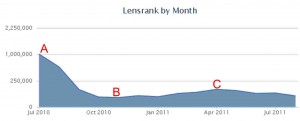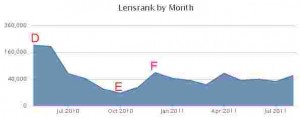There are two reasons why I try to publish a Squidoo lens the same day it’s created. The first is all about lens stats.
I’m a stats junkie and like using graphs to analyze lens performance trends. One of my Squidoo pet peeves is that an unpublished lens’s lensrank is included on the stats page lensrank graph. A newly created, unpublished lens currently gets a lensrank around 1,400,000. Since the graph includes all values, lensranks that high increase the y-axis (the vertical line) range so much that it’s difficult to analyze trends of the published lensranks. Those are the values that matter since they determine pay tiers.
SquidHQ improved this some with the recent graph redesign. Only plotting the monthly average lensrank can reduce the max value if the lens is published within the same month. There’s now a mouse over showing the actual value and date for each point. Squidoo also went from a linear graph to a log-lin graph. That gives the lower values more space than the higher values. It’s why the y-axis intervals will be 0, 40000, 160000, 360000 on a graph instead of in even increments.
Best of all is the option to click “By day” and see only the last three month’s daily lensrank graphed. You won’t be able to see the lifetime trends in this view, but if your lens was published more than three months ago, the graph will be scaled to a usable range.
Below is the lensrank graph for a lens not published on the day it was created…

Fig. 1: Lensrank Graph of a lens not published on the same day as created.
The lens was created in July (point A) and had an average lensrank of just over one million. Note the huge span of the y-axis, from 0 to 2,250,000. After the lens was published in August and lensrank moved to a normal range, its best rank was at point B and then fell off to point C. But how bad of a shift was that? It doesn’t look like much on the graph. Is it a difference of 5,000 spots? 10,000? 30,000? I can’t really tell without using the mouse overs. The answer is nearly 81,000 spots. It went from a solid Tier 3 to well into Tier 4.
To get around this, I try to create and publish a lens in the same day. Doesn’t always work out that way, but I try.
How does that help? By publishing the lens before the next daily lensrank calculation, its first lensrank will be that of a newly published lens (currently around 260,000, assuming no traffic). So the y-axis scale doesn’t have such a large range and the lensrank graph is more usable. Here’s an example…

Fig. 2: Lensrank Graph of a lens published the same day as created.
This lens launched at point D with a lensrank of 205,000. The y-axis range is 0 to 360,000…not ideal but much better than the values in Fig. 1. It’s easier on this graph to gauge the ups and downs of the lensrank value thanks to a smaller y-axis range and the line at 40,000. You can see that when the lens hit its best lensrank at point E it was below 40,000 and above 40,000 when it got to F. The actual values are 9,101 for E and almost 62,000 for F.
This graph would look even better if the lens had seen some traffic and interaction on its first days at sea. That would’ve earned it a better lensrank at the start and a smaller y-axis range.
The second reason to create and publish in the same day is to get the lens done…or at least presentable. If I let an unpublished lens sit longer than a day or two, I might switch gears to something else. It could be a week or more before the lens finally gets published.
No matter if you publish your lens on the day it’s created or not, only publish a lens when it’s ready. It should be coherent and offer value to any readers that may stumble across it. If the lens still looks like it’s under construction, then leave it in WIP status. Many of my lenses didn’t get published on the same day they were created because I couldn’t get a sufficient amount of content written or organized in time. I may obsess on stats sometimes but I’ll never sacrifice quality for stats.
